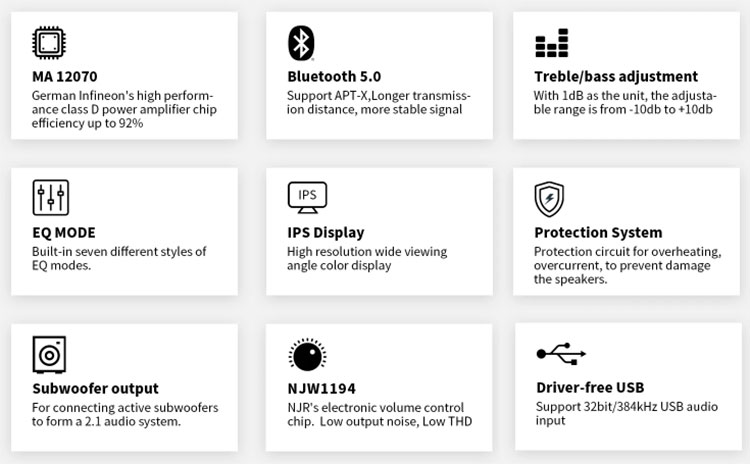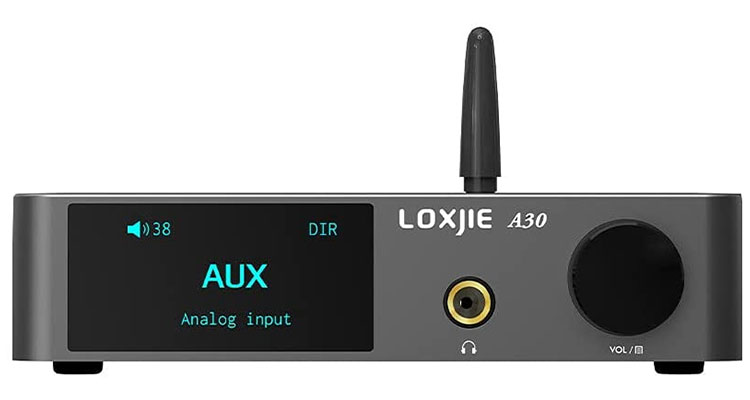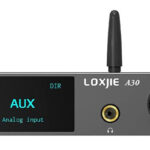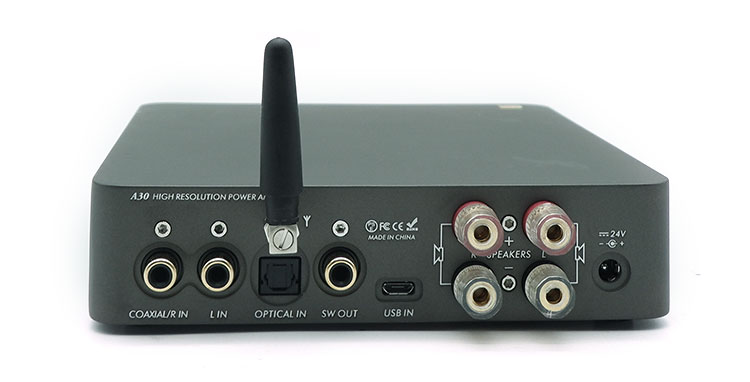The Loxjie A30 is a compact balanced desktop integrated headphone and speaker amplifier with Bluetooth capability. It is priced at $189.99.
Disclaimer: The Loxjie A30 sent to us is a sample in exchange for our honest opinion. We thank the team at Loxjie for giving us this opportunity.
To read more about Loxjie products we have reviewed on Headfonics click here.
Note, this 2-page review follows our new scoring guidelines for 2021 which you can read up on here.
These days, I’ve come to associate the Loxjie brand with products that have plenty of features at a very competitive price point. Recently, we’ve had the privilege to take a closer look at their D30, which we found to be a versatile compact desktop DAC/Amp with sensible features that make it a great desktop control center.
This week, we take a closer look at the Loxjie A30. This is a compact integrated amplifier complete with a DAC input, Bluetooth, and analog inputs.

Tech Highlights
Being an integrated amplifier, the A30 is equipped with an ESS 9023 DAC chip, and Bluetooth connectivity using a Qualcomm chipset allowing the A30 to receive Bluetooth 5.0 signals with aptX. Using a wired connection, the 9023 DAC chip allows the A30 to decode PCM streams up to 32bit/384kHz.
The power amplifier section on the A30 is based on a class D Infineon 12070 chip from Germany which makes the A30 capable of 80W into 4Ω and 40W into 8Ω, something rather impressive for such a small package.
As a headphone amplifier, the A30 is capable of 100mW into a 32Ω load. To take good control over the high power output capabilities of the A30, it also has an NJW1194 volume control chip which ensures accurate volume tracking.
The A30 has been measured to have an SNR of as low as 108dB, and a THD of 0.003% making the noise floor mostly inaudible.
Design
Built as an integrated amplifier, the A30 has speaker outputs at the rear. Despite having 5-way binding posts, the more crowded arrangement of the speaker terminals will make using bare wires very difficult. So I suggest having at least spades or banana plugs to make termination less cumbersome.
Being a feature-packed device, every square inch in the rear of the device has to be used efficiently. This means space-saving measures such as the use of a micro USB-B port at the rear, and making the R-RCA connector double as a coaxial input.
Overall, there are some smart choices, and some compromises to ensure that there is enough space in the rear to accommodate the available inputs and outputs on the A30.
To ensure that the A30 will have enough power to run all these features, it comes bundled with an external 24V/2.1A switch mode power supply. This also saves some space both internally and at the rear of the device.
I/O
Despite the deceptively small frame, the A30 can truly be classified as an integrated amplifier. For inputs, the A30- is equipped with both analog and digital inputs.
The A30 is a bit more limited with the available options for analog input since there is only a pair of single-ended RCA input. For digital inputs though, there are more options including USB, coaxial, optical, and even Bluetooth 5.0.
As an integrated amplifier, the A30 has 2 options for its outputs. The first is through the rear speaker terminals that allow the A30 to output to passive speakers. Another option is using the ¼” single-ended headphone jack in front of the device.
Controls
There are 2 main ways to interact with the A30, the first is directly going through the menu using the volume knob on the device. Although this is quite efficient, it would be more difficult to do from a distance if the A30 is used as an integrated amplifier.
The other way to interact with the A30 is using the remote control that’s also provided. Controls using the remote control are intuitive and allow for full control over all the options that are available with the A30.
Although the A30 is equipped with a colored IPS screen, the screen is mainly a combination of black and any other color chosen in the menu. I believe this is a well-thought-out design choice since it allows for better visibility from a distance, so it will be easier to control the device from the comfort of your listening chair.
When the device is first activated, there is a screen that shows the volume level, output mode, input mode, and the sample rate/status of that input.
Browsing through the menu, the A30 allows for many options, including input selection, output controls that will allow the user to choose to either output to headphones or speakers, but not both. Other controls include EQ controls, display color, BT clear, and Dimmer.
Packaging & Accessories
The package that the A30 arrives in is nothing to write home about, but that’s not necessarily a bad thing. It arrives in a simple cardboard box that shows the model number and a sketch of the product itself. Inside it contains a sufficient amount of foam inserts that keep both the A30 and the accessories safe during transport and storage.
While the packing of the A30 is relatively simple, the accessories that arrive with it are comprehensive. Together with the A30, there is an external switch-mode power supply, a standard IEC power cord, a USB cable, a Bluetooth aerial, a remote control, and of course the manuals and warranty information.
Sound Impressions
The sound impressions done with the A30 were completed using the analog inputs and output combined with the D30 DAC using either speakers or headphones. All impressions are with the A30 set in direct EQ mode.
Summary
Based on my experience with class D amplifiers, they tend to be colder, drier, and more controlled sounding. There is also a slight compression to the presentation. To some extent, the A30 doesn’t stray away from those characteristics. Where the A30 tends to have a drier presentation while maintaining good control over the drivers of both speakers and headphones.
However, the A30 also strays away from the typical class D sound by adding some coloration and warmth to the presentation, making it an overall more exciting but smoother listening experience.
Timbre
Most amplifiers of late strive to adhere to a very strict standard of neutrality, however, the A30 goes against the grain by injecting some coloration into the music.
While the bass is generally extended, there is an evident midbass hump that adds more weight to each bass note. This also allows drum hits to have more body and texture, while still generally maintaining control over the bass common to most class D amplifiers.
Although the vocal range is clear and crisp, the fundamentals of the vocal range are more pushed back compared to the rest of the frequency spectrum. This would then be contrasted by an uplift in the upper midrange, making some recordings more shouty if you’re not careful.
Treble frequencies are generally subdued, ensuring that the A30 won’t be too intrusive. So cymbal hits won’t be glaringly bright, but still acceptably crisp and clear. There isn’t any roll-off in the upper treble regions, so the A30 allows for airier headphones or speakers to remain so.
Staging & Dynamics
The A30 doesn’t create an artificially expansive soundstage, instead, it just maintains the natural sense of space and width of the soundstage. The imaging presentation is generally accurate allowing for images within the soundstage to be directionally accurate, creating a center image that’s crisp and well defined, while off-center images may not be as strikingly accurate.
Layering within the soundstage isn’t the A30’s strong suit, so some images will not go deep into the soundstage. While there is some layering within the soundstage, the images don’t venture too deep into the soundstage creating a more compressed imaging presentation.
DAC Input
When running directly into the A30’s DAC section, it generally retains most of the tonal balance of the A30 running as an amplifier so it’s still generally energetic. Most of the detail retrieval capability is maintained as well, allowing the A30 to still flesh out the nuances of the track.
When it comes to creating a soundstage, the internal DAC creates a generally expansive soundscape. However, when it comes to creating layers within the soundstage, the layers end up a bit more compressed particularly when compared to stand-alone DACs such as the A30’s stablemate the Loxjie D30.
Bluetooth Performance
With an option for Bluetooth connection, the A30 makes for a comprehensive solution as an integrated amplifier.
While it maintains control over most headphones and speakers even when it’s run using Bluetooth, there is a surprising amount of bass bloom when it’s connected to Bluetooth. Although this doesn’t make the bass bleed into the midrange, it makes it a bit overpowering for already warmer speakers or headphones.
Click on page 2 below for pairings and select comparisons.






